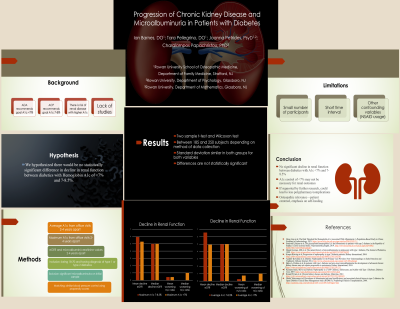Back

Clinical: Outcomes Studies
Progression of Chronic Kidney Disease and Microalbuminuria in Patients with Diabetes
Friday, March 31, 2023
12:00 PM East Coast USA Time


Ian Barnes, DO (he/him/his)
Resident Physician
Rowan University School of Osteopathic Medicine
Philadelphia, Pennsylvania, United States
Presenting Author(s)
Background and Hypothesis: The ADA recommends a goal hemoglobin A1c of < 7%, and the ACP recommends 7-8%. While higher hemoglobin A1c is known to increase risk of kidney disease, there are currently no studies analyzing decline in eGFR and worsening of microalbuminuria in diabetic patients with A1c of < 7% versus those with A1c of 7-8.5%.
We hypothesized there would be no statistically significant difference in decline in renal function between diabetics with Hemoglobin A1c of < 7% and 7-8.5%.
Methods: This study is a retrospective chart review. The data is comprised of patients of the Rowan University School of Osteopathic Medicine clinics. Selecting individuals within these hemoglobin A1c parameters was done in two ways—by taking individuals’ average hemoglobin A1c between two office visits and taking their maximum hemoglobin A1c between two office visits. Decline in renal function was measured by looking at eGFR and microalbumin/creatinine ratio on two occasions, 2-4 years apart. The individuals included were ages 18-70 and carried a diagnosis of type 1 or type 2 diabetes. Those with clinically significant microalbuminuria in their initial sample were excluded. We matched subjects for similar blood pressure control using propensity scores.
Results: The data encompasses two groups of participants with 185 and 250 subjects. The two groups represent those selected based on average hemoglobin A1c and maximum hemoglobin A1c, respectively. In both groups, two sample t-test and Wilcoxon test suggest no significant difference in decline in renal function between those with A1c of < 7% and those with A1c of 7-8.5% (p = 0.116).
Conclusion: The data demonstrates no difference in decline in renal function between those with hemoglobin A1c < 7% and those with hemoglobin A1c between 7% and 8.5%. This finding could signify that, to decrease the risk of renal disease secondary to diabetes, A1c control of < 7% may not be necessary. This finding, if supported by further research, could lead to decreased polypharmacy and drug-induced hypoglycemia in diabetics in the future. This is osteopathically relevant, as efforts to decrease polypharmacy and medication side effects are patient-centered and highlight the ability of the human body to self-heal.
Acknowledgement of Research Study Sponsors and IRB: The Rowan University Institutional Review Board approved this study.
We hypothesized there would be no statistically significant difference in decline in renal function between diabetics with Hemoglobin A1c of < 7% and 7-8.5%.
Methods: This study is a retrospective chart review. The data is comprised of patients of the Rowan University School of Osteopathic Medicine clinics. Selecting individuals within these hemoglobin A1c parameters was done in two ways—by taking individuals’ average hemoglobin A1c between two office visits and taking their maximum hemoglobin A1c between two office visits. Decline in renal function was measured by looking at eGFR and microalbumin/creatinine ratio on two occasions, 2-4 years apart. The individuals included were ages 18-70 and carried a diagnosis of type 1 or type 2 diabetes. Those with clinically significant microalbuminuria in their initial sample were excluded. We matched subjects for similar blood pressure control using propensity scores.
Results: The data encompasses two groups of participants with 185 and 250 subjects. The two groups represent those selected based on average hemoglobin A1c and maximum hemoglobin A1c, respectively. In both groups, two sample t-test and Wilcoxon test suggest no significant difference in decline in renal function between those with A1c of < 7% and those with A1c of 7-8.5% (p = 0.116).
Conclusion: The data demonstrates no difference in decline in renal function between those with hemoglobin A1c < 7% and those with hemoglobin A1c between 7% and 8.5%. This finding could signify that, to decrease the risk of renal disease secondary to diabetes, A1c control of < 7% may not be necessary. This finding, if supported by further research, could lead to decreased polypharmacy and drug-induced hypoglycemia in diabetics in the future. This is osteopathically relevant, as efforts to decrease polypharmacy and medication side effects are patient-centered and highlight the ability of the human body to self-heal.
Acknowledgement of Research Study Sponsors and IRB: The Rowan University Institutional Review Board approved this study.
